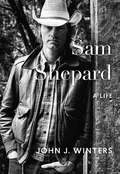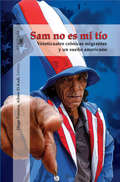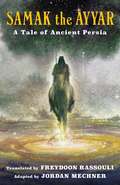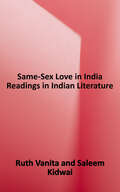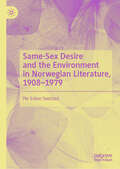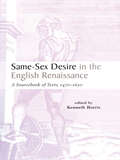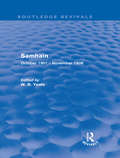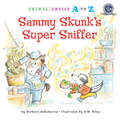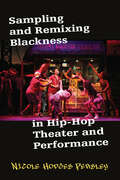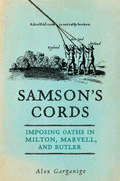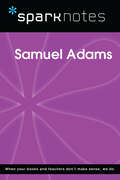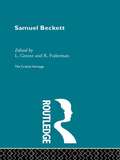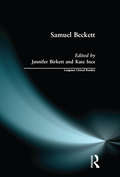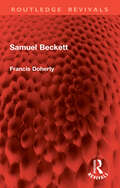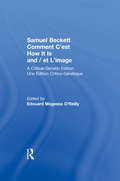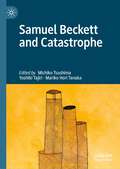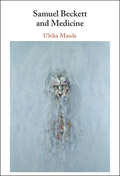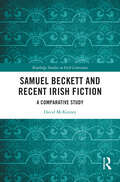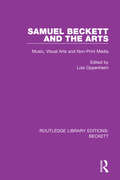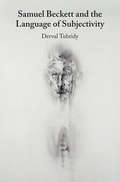- Table View
- List View
Sam Shepard: A Life
by John J. Winters“John Winters offers a master class in literary sleuthing, untangling the many lives and unearthing the origin story of America’s foremost Renaissance man of letters.” —Kelly Horan, coauthor of Devotion and DefianceWith more than fifty–five plays to his credit—including the 1979 Pulitzer Prize–winning Buried Child, an Oscar nod for his portrayal of Chuck Yeager in The Right Stuff, and an onscreen persona that’s been aptly summed up as “Gary Cooper in denim”—Sam Shepard’s impact on American theater and film ranks with the greatest playwrights and actors of the past half–century.Sam Shepard: A Life gets to the heart of Sam Shepard, presenting a compelling and comprehensive account of his life and work.In a new epilogue, added by the author after Shepard’s untimely death in July of 2017, John J. Winters offers a glimpse into the enigmatic author’s last days, when very few knew he was suffering from ALS.“An excellent biography . . . Mr. Winters is especially good on the backstage of one of Mr. Shepard’s most frequently revived works, True West . . . Mr. Winters has an interesting story to tell, and he recounts it ably, bringing us close to a figure who, he admits, avoids intimacy.” —The Wall Street Journal“A new, thoroughly researched biography . . . Winters does indeed capture a personality more anxious and self–doubting than previous biographers have grasped.” —The Washington Post“Meticulously presents the facts of Shepard’s complex life along with incisive descriptions and analyses of diverse productions of Shepard’s demanding and innovative plays . . . Winters portrays Shepard as a magnetic, enigmatic, and multitalented artist drawing on a deep well of loneliness and self–questioning, keen attunement to the zeitgeist, and penetrating insight into human nature.” —Booklist (starred review)
Sam no es mi tío: Veinticuatro crónicas migrantes y un sueño americano
by Diego Fonseca Aileen El-Kadi V.V.A.A V.V.A.ACon crónicas de Daniel Alarcón, Jorge Volpi, Santiago Roncagliolo, Ilán Stavans, Edmundo Paz Soldán, Claudia Piñeiro, Jon Lee Anderson, Joaquín Botero, João Paolo Cuenca, André de Leones, Aileen El-Kadi, Gabriela Esquivada, Diego Fonseca, Eduardo Halfon, Yuri Herrera, Hernán Iglesias Illa, Andrea Jeftanovic, Camilo Jiménez, Juan Pablo Meneses, Diego Enrique Osorno, Guillermo Osorno, Carola Saavedra, Wilbert Torre y Eloy Urroz.Veinticuatro cronistas participan en Sam no es mi tío, escritores, periodistas, y académicos latinoamericanos que se propusieron narrar América, las Américas. Para ellos la realidad está compuesta por millones de historias como las suyas que conforman nuestras sociedades. Estas crónicas son los relatos de la microhistoria americana contemporánea. Donde las eternas migraciones, la violencia, las partidas y los regresos, el éxito y la derrota, los cruces lingüísticos y culturales, el racismo y la xenofobia cohabitan dentro de un relato que permanecerá siempre incompleto.El lector de estas crónicas va a acompañar trayectos tan fascinantes como familiares. Se acercará a mundos bajos de los que ya escuchó hablar alguna vez. Reirá y sufrirá con los protagonistas de historias reales, tan reales como las de aquel amigo, aquella prima, aquel padre que se fue al Norte, pero nunca contó qué pasó por allá. O la de una mujer y su amante que ven por la tele la caída de las Torres Gemelas mientras especulan si su esposo murió en el ataque; o un norteamericano que se dedica a defender latinos pobres que más tarde lo van a traicionar.
Samak the Ayyar: A Tale of Ancient Persia
by Mechner, Jordan; Rassouli, FreydoonThe adventures of Samak, a trickster-warrior hero of Persia’s thousand-year-old oral storytelling tradition, are beloved in Iran. Samak is an ayyar, a warrior who comes from the common people and embodies the ideals of loyalty, selflessness, and honor—a figure that recalls samurai, ronin, and knights yet is distinctive to Persian legend. His exploits—set against an epic background of palace intrigue, battlefield heroics, and star-crossed romance between a noble prince and princess—are as deeply rooted in Persian culture as are the stories of Robin Hood and King Arthur in the West. However, this majestic tale has remained little known outside Iran.Translated from the original Persian by Freydoon Rassouli and adapted by Prince of Persia creator Jordan Mechner, this timeless masterwork can now be enjoyed by English-speaking readers. A thrilling and suspenseful saga, Samak the Ayyar also offers a vivid portrait of Persia a thousand years ago. Within an epic quest narrative teeming with action and supernatural forces, it sheds light on the lives of ordinary people and their social worlds. This is the first complete English-language version of a treasure of world culture. The translation is grounded in the twelfth-century Persian text while paying homage to the dynamic culture of storytelling from which it arose.
Samayappadalkalum Sitrilakkiyangalum Kappiyangalum: சமயப்பாடல்களும் சிற்றிலக்கியங்களும் காப்பியங்களும்
by Institute Of Distance Education - University Of Madrasஇந்த புத்தகத்திலிருந்து திருஞானசம்பந்தர், மாணிக்கவாசகர், கலிங்கத்துப்பரணி, தமிழ்விடுதூது, சிலப்பதிகாரம் போன்ற பாடங்களை அறிந்து கொள்ளலாம்.
Same Sex Love in India: Readings from Literature and History
by Ruth Vanita Saleem KidwaiSame-Sex Love in India presents a stunning array of writings on same-sex love from over 2000 years of Indian literature. Translated from more than a dozen languages and drawn from Hindu, Buddhist, Muslim, and modern fictional traditions, these writings testify to the presence of same-sex love in various forms since ancient times, without overt persecution. This collection defies both stereotypes of Indian culture and Foucault's definition of homosexuality as a nineteenth-century invention, uncovering instead complex discourses of Indian homosexuality, rich metaphorical traditions to represent it, and the use of names and terms as early as medieval times to distinguish same-sex from cross-sex love. An eminent group of scholars have translated these writings for the first time or have re-translated well-known texts to correctly make evident previously underplayed homoerotic content. Selections range from religious books, legal and erotic treatises, story cycles, medieval histories and biographies, modern novels, short stories, letters, memoirs, plays and poems. From the Rigveda to Vikram Seth, this anthology will become a staple in courses on gender and queer studies, Asian studies, and world literature.
Same-Sex Desire and the Environment in Norwegian Literature, 1908–1979
by Per Esben SvelstadThis book explores how ideas of nature and the nonhuman play an important part in literary depictions of same-sex desire in twentieth-century Norwegian literature. Critically probing dichotomies such as pastoral/urban and human/animal, the chapters show how literary fiction constructs, represents, and interprets experiences of same-sex love and attraction, traditionally conceived as “unnatural.” Providing in-depth studies of a variety of texts, this book demonstrates the merits of bridging the gap between the “de-naturalizing” project of gender and queer theory on the one hand, and, on the other, the ecocritical centering of material, nonhuman environments.
Same-Sex Desire in the English Renaissance: A Sourcebook of Texts, 1470-1650 (Garland Studies in the Renaissance #Vol. 12)
by Kenneth BorrisThe readings gathered here include many rare texts that have not been reprinted for centuries, excerpted from biblical commentary, legal writings, medical and scientific writings, popular encyclopedias, and literature, as well as continental vernacular and Latin sources never before available in English translation. The selections are assembled in ten chapters addressing particular discursive fields - Theology, Law, Medicine, Astrology, Physiognomics, Encyclopedias and Reference Works, Prodigious Monstrosities, Love and Friendship, the Sapphic Renaissance, and Erotica. Each chapter includes a substantial introduction summarizing its topic and its relation to early modern homoeroticism. The volume also poignantly addresses key issues in Renaissance thinking about sexual identity, and newly clarifies central problems and debates in the historiography of same-sex love.
Samhain: October 1901 - November 1908 (Routledge Revivals)
by W. B. YeatsFirst published in 1970, this book includes all of the annual editions and also a final pamphlet of Samhain: October 1901 – November 1908, a literary magazine edited by W. B. Yeats. Samhain was one of the several magazines that the Irish Literary Theatre (later to become The Abbey Theatre) produced and it was born when the original magazine, Beltaine, came to an end in 1900. Yeats’s editorial role was essential to the publication which served to publicize the work of the Theatre, promote current works of Irish playwrights and challenging those of their English opponents.The magazine mainly consists of a series of essays on the theatre in Dublin, and supplementing these are explanations and discussions of new plays, excerpts from which are often included. This book will be of interest to those with an interest in Yeats, early nineteenth-century literature, and Irish theatre.
Sammy Skunk's Super Sniffer (Animal Antics A to Z)
by Barbara deRubertisSammy Skunk’s super sniffer can be super helpful. But when he tries to help the new cook at school, he accidentally stirs up some very soupy trouble!
Samoan Alphabet (Island Alphabet Books)
by Lori PhillipsThis book is part of the Island Alphabet Books series, which features languages and children's artwork form the U.S.-affiliated Pacific. Each book contains the complete alphabet for the language, four or five examples for each letter, and a word list with English translations.
Sampling and Remixing Blackness in Hip-hop Theater and Performance
by Nicole Hodges PersleySampling and Remixing Blackness is a timely and accessible book that examines the social ramifications of cultural borrowing and personal adaptation of Hip-hop culture by non-Black and non-African American Black artists in theater and performance. In a cultural moment where Hip-hop theater hits such as Hamilton offer glimpses of Black popular culture to non-Black people through musical soundtracks, GIFs, popular Hip-hop music, language, clothing, singing styles and embodied performance, people around the world are adopting a Blackness that is at once connected to African American culture--and assumed and shed by artists and consumers as they please. As Black people around the world live a racial identity that is not shed, in a cultural moment of social unrest against anti-blackness, this book asks how such engagements with Hip-hop in performance can be both dangerous and a space for finding cultural allies. Featuring the work of some of the visionaries of Hip-hop theater including Lin-Manuel Miranda, Sarah Jones and Danny Hoch, this book explores the work of groundbreaking Hip-hop theater and performance artists who have engaged Hip-hop's Blackness through popular performance. The book challenges how we understand the performance of race, Hip-hop and Blackness in the age of Instagram, TikTok and Facebook. In a cultural moment where racial identity is performed through Hip-hop culture's resistance to the status quo and complicity in maintaining it, Hodges Persley asks us to consider who has the right to claim Hip-hop's blackness when blackness itself is a complicated mixtape that offers both consent and resistance to transgressive and inspiring acts of performance.
Samson Occom: Radical Hospitality in the Native Northeast (Religion, Culture, and Public Life #48)
by Ryan CarrThe Mohegan-Brothertown minister Samson Occom (1723–1792) was a prominent political and religious leader of the Indigenous peoples of present-day New York and New England, among whom he is still revered today. An international celebrity in his day, Occom rose to fame as the first Native person to be ordained a minister in the New England colonies. In the 1770s, he helped found the nation of Brothertown, where Coastal Algonquian families seeking respite from colonialism built a new life on land given to them by the Oneida Nation. Occom was a highly productive author, probably the most prolific Native American writer prior to the late nineteenth century. Most of Occom’s writings, however, have been overlooked, partly because many of them are about Christian themes that seem unrelated to Native life.In this groundbreaking book, Ryan Carr argues that Occom’s writings were deeply rooted in Indigenous traditions of hospitality, diplomacy, and openness to strangers. From Occom’s point of view, evangelical Christianity was not a foreign culture; it was a new opportunity to practice his people’s ancestral customs. Carr demonstrates Occom’s originality as a religious thinker, showing how his commitment to Native sovereignty shaped his reading of the Bible. By emphasizing the Native sources of Occom’s evangelicalism, this book offers new ways to understand the relations of Northeast Native traditions to Christianity, colonialism, and Indigenous self-determination.
Samson and Delilah in Medieval Insular French: Translation and Adaptation (The New Middle Ages)
by Catherine LégluSamson and Delilah in Medieval Insular French investigates several different adaptations of the story of Samson that enabled it to move from a strictly religious sphere into vernacular and secular artworks. Catherine Léglu explores the narrative’s translation into French in medieval England, examining the multiple versions of the Samson narrative via its many adaptations into verse, prose, visual art and musical. Utilizing a multidisciplinary approach, this text draws together examples from several genres and media, focusing on the importance of book learning to secular works. In analysing this Biblical narrative, Léglu reveals the importance of the Samson and Delilah story as a point of entry into a fuller understanding of medieval translations and adaptations of the Bible.
Samson’s Cords: Imposing Oaths in Milton, Marvell, and Butler
by Alex GarganigoIn seventeenth-century Britain every debate about loyalty oaths invoked the biblical Samson. Samson’s Cords argues that these loyalty tests became an unprecedentedly pervasive feature of life in Restoration England and that writers of satire and epic had no choice but to respond. Alex Garganigo examines the radically different responses of John Milton, Andrew Marvell, and Samuel Butler to the existential crises caused by this explosion of loyalty oaths. After early support, all three developed serious reservations, confronting the irony that while oaths often exclude and destroy, they also include and create. Tackling issues such as performance, ritual, religion, secularization, gender, swearing, republicanism, and citizenship, Garganigo offers original readings of Paradise Lost, Samson Agonistes, An Horatian Ode upon Cromwell’s Return from Ireland, The Rehearsal Transpros’d, and Hudibras.
Samuel Adams (SparkNotes Biography Guide)
by SparkNotesSamuel Adams (SparkNotes Biography Guide) Making the reading experience fun! SparkNotes Biography Guides examine the lives of historical luminaries, from Alexander the Great to Virginia Woolf. Each biography guide includes:An examination of the historical context in which the person lived A summary of the person&’s life and achievements A glossary of important terms, people, and events An in-depth look at the key epochs in the person&’s career Study questions and essay topics A review test Suggestions for further reading Whether you&’re a student of history or just a student cramming for a history exam, SparkNotes Biography guides are a reliable, thorough, and readable resource.
Samuel Beckett
by L. Graver R. FedermanThis set comprises 40 volumes covering 19th and 20th century European and American authors. These volumes will be available as a complete set, mini boxed sets (by theme) or as individual volumes. This second set compliments the first 68 volume set of Critical Heritage published by Routledge in October 1995.
Samuel Beckett (Longman Critical Readers)
by Jennifer Birkett Kate InceBringing together seminal writings on Beckett from the 1950s and 1960s with critical readings from the 1980s and 1990s, this collection is inspired by a wide variety of literary-theoretical approaches and covers the whole range of Beckett's creative work. Following an up-to-date review and analysis of Beckett criticism, fifteen extracts of Beckett criticism are introduced and set in context by editors' headnotes. The book aims to make easily accessible to students and scholars stimulating and innovative writing on the work of Samuel Beckett, representing the wide range of new perspectives opened up by contemporary critical theory: philosophical, political and psychoanalytic criticism, feminist and gender studies, semiotics, and reception theory.
Samuel Beckett (Routledge Revivals)
by Francis DohertyOriginally published in 1971, this book elucidates Beckett’s work in the light of his concern with literary form. This is seen as an increasingly compressed and dense medium for the purer and purer statement of his view of man’s existence, and Beckett’s Man is seen as the medium for the articulation of a view of the world which is both comically cruel and anti-theological, but not atheist. The book discusses his work as a novelist and playwright – his best-known play, Waiting for Godot, being seen in the context of his many other important plays, and more than twenty years of previous writing.
Samuel Beckett Comment C'est How It Is And / et L'image: A Critical-Genetic Edition Une Edition Critic-Genetique
by Samuel BeckettThis book contains the English and French texts and a complete record of the genesis of each. Besides Comment C'est How It Is, O'Reilly has included L'Image and an excerpt from Comment C'est that was published later in another volume.
Samuel Beckett and Catastrophe
by Mariko Hori Tanaka Yoshiki Tajiri Michiko TsushimaSamuel Beckett and Catastrophe is a groundbreaking collection of original essays that explore the relation between Samuel Beckett and catastrophe in terms of war, the Holocaust, nuclear disasters and ecological crisis. Responding to the post-catastrophic situations in the twentieth century, Beckett created characters who often seem to have been through an unknown catastrophe. Although the importance of catastrophe in Beckett has been noted sporadically, there has been no substantial attempt to discuss his aesthetics and work in relation to it. This collection will therefore serve as the first sustained study to explore the theme of catastrophe in Beckett and will be a highly significant contribution to Beckett studies.
Samuel Beckett and Cultural Nationalism (Elements in Beckett Studies)
by Shane WellerDrawing on evidence from his published works, manuscripts, and correspondence, Samuel Beckett and Cultural Nationalism explores Beckett's engagement with the theme of cultural nationalism throughout his writing life, revealing the various ways in which he sought to challenge culturally nationalist conceptions of art and literature, while never embracing a cosmopolitan approach. The Element shows how, in his pre-Second World War writings, Beckett sought openly to mock Irish nationalist ideas of culture and language, but that, in so doing, he failed to avoid what he himself described as a 'clot of prejudices'. In his post-war works in French and English, however, following time spent in Nazi Germany in 1936-7 as well as in the French Resistance during the Second World War, Beckett began to take a new approach to ideas of national-cultural affiliation, at the heart of which was a conception of the human as a citizen of nowhere.
Samuel Beckett and Medicine
by Ulrika MaudeSamuel Beckett and Medicine offers the first sustained analysis of the author's abiding interest in medicine and medical discourses, advancing insights into the representation of illness, neurodiversity, disability, ageing, and dying in his work. It analyses Beckett's representation of the production of language, offering new ways of understanding the often perplexing formal and stylistic experimentation of his work. The book addresses the many automatic and habitual functions staged in his writing and considers the impact of nerve theory, reflexes, affect, and the viscera on his work. It advances new readings of Beckett's poetry, prose, and television and stage plays, drawing on his reading notes on medicine and psychology, and on his correspondence and critical writings. Through its refusal to aestheticize embodied experience or to yield to the metaphysical consolations of literature, Beckett's work challenges us to confront the intricacies of embodied being and to encounter the question of finitude.
Samuel Beckett and Recent Irish Fiction: A Comparative Study (Routledge Studies in Irish Literature)
by David McKinneyThis volume considers Samuel Beckett’s fiction and drama as major aesthetic and thematic influences on the work of Irish authors Eimear McBride, Keith Ridgway, Emma Donoghue, and Kevin Barry in the post-crash period of 2009–2015. Through cross-comparisons between the aesthetics and form of Beckett’s Trilogy, Mercier and Camier, Footfalls and Not I, and those of a range of post-crash Irish novels including Beatlebone, Hawthorn and Child, Room, and A Girl Is A Half-Formed Thing, this book establishes Beckett’s continuing influence on Irish fiction. With particular reference to these newer authors’ treatment of scarcity, trauma, indeterminism, gender and sexuality, and confinement in the context of major societal changes and traumas in Irish society since 2009, topics include the imposition of austerity, collapse of faith in institutions, and the increasing recognition of LGBTQIA+ and reproductive rights.
Samuel Beckett and the Arts: Music, Visual Arts and Non-Print Media (Routledge Library Editions: Beckett #4)
by Lois OppenheimThis book, first published in 1999, addresses Beckett’s visual and musical sensibilities, and examines his visionary use of such diverse modes of creative expression as stage, radio, television and film, when his medium was the written word. The first section of the book focuses on music; the second part analyses the visual arts; and the third part examines film, radio and television. This book uncovers aspects of his thinking on, and use of the arts that have been little studied, including the nonfigurative function of music and art in Beckett’s work; the ‘collaborations’ undertaken by composers, painters and choreographers with his texts; the relation of his literary to his visual and musical artistry; and his use of film, radio and television as innovative means and celebration of artistic process.
Samuel Beckett and the Language of Subjectivity
by Derval TubridySamuel Beckett and the Language of Subjectivity is the first sustained exploration of aporia as a vital, subversive, and productive figure within Beckett's writing as it moves between prose and theatre. Informed by key developments in analytic and continental philosophies of language, Tubridy's fluent analysis demonstrates how Beckett's translations - between languages, genres, bodies, and genders - offer a way out of the impasse outlined in his early aesthetics. The primary modes of the self's extension into the world are linguistic (speaking, listening) and material (engaging with bodies, spaces and objects). Yet what we mean by language has changed in the twenty-first century. Beckett's concern with words must be read through the information economy in which contemporary identities are forged. Derval Tubridy provides the groundwork for new insights on Beckett in terms of the posthuman: the materialist, vitalist and relational subject cathected within differential mechanisms of power.
